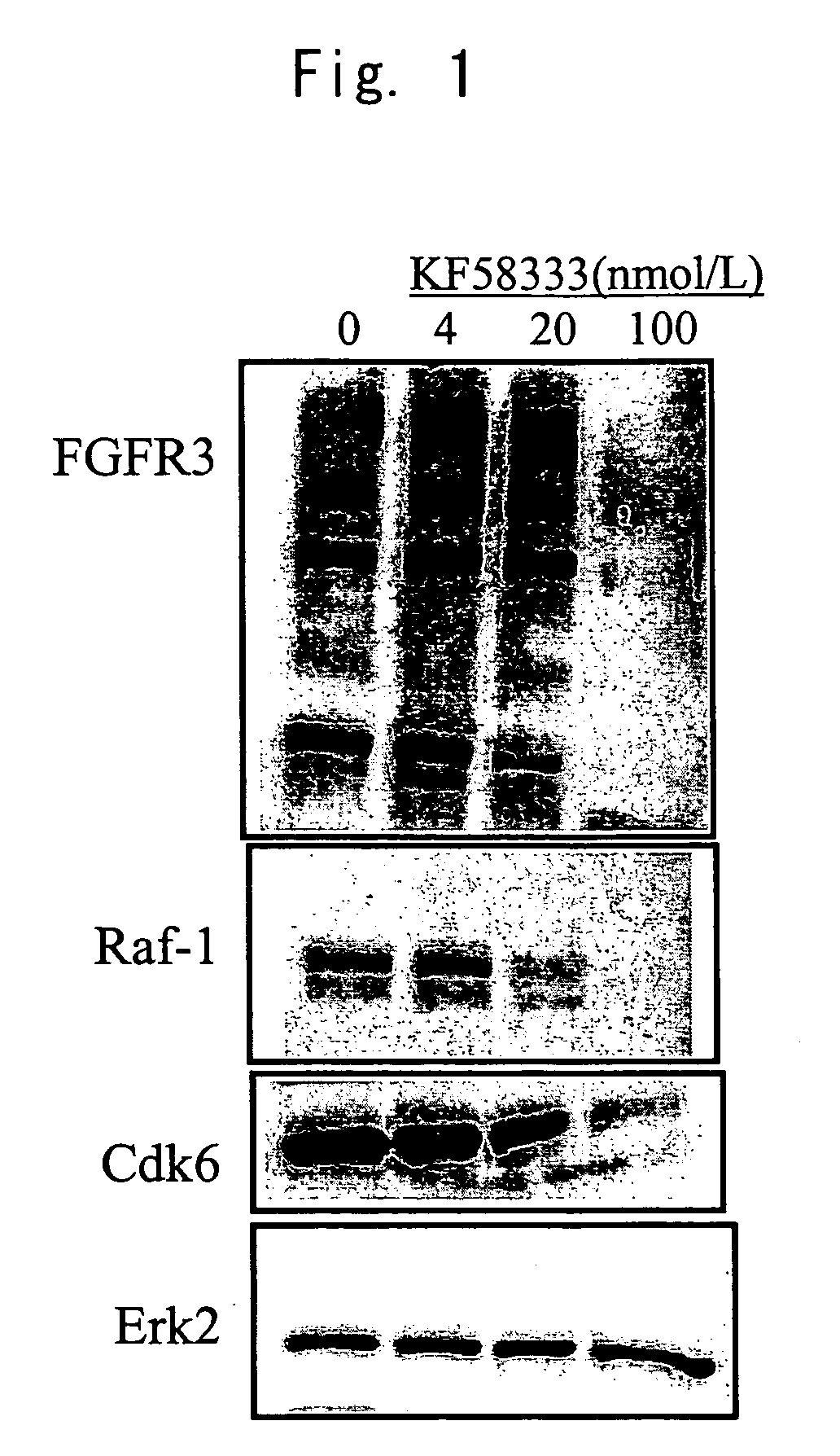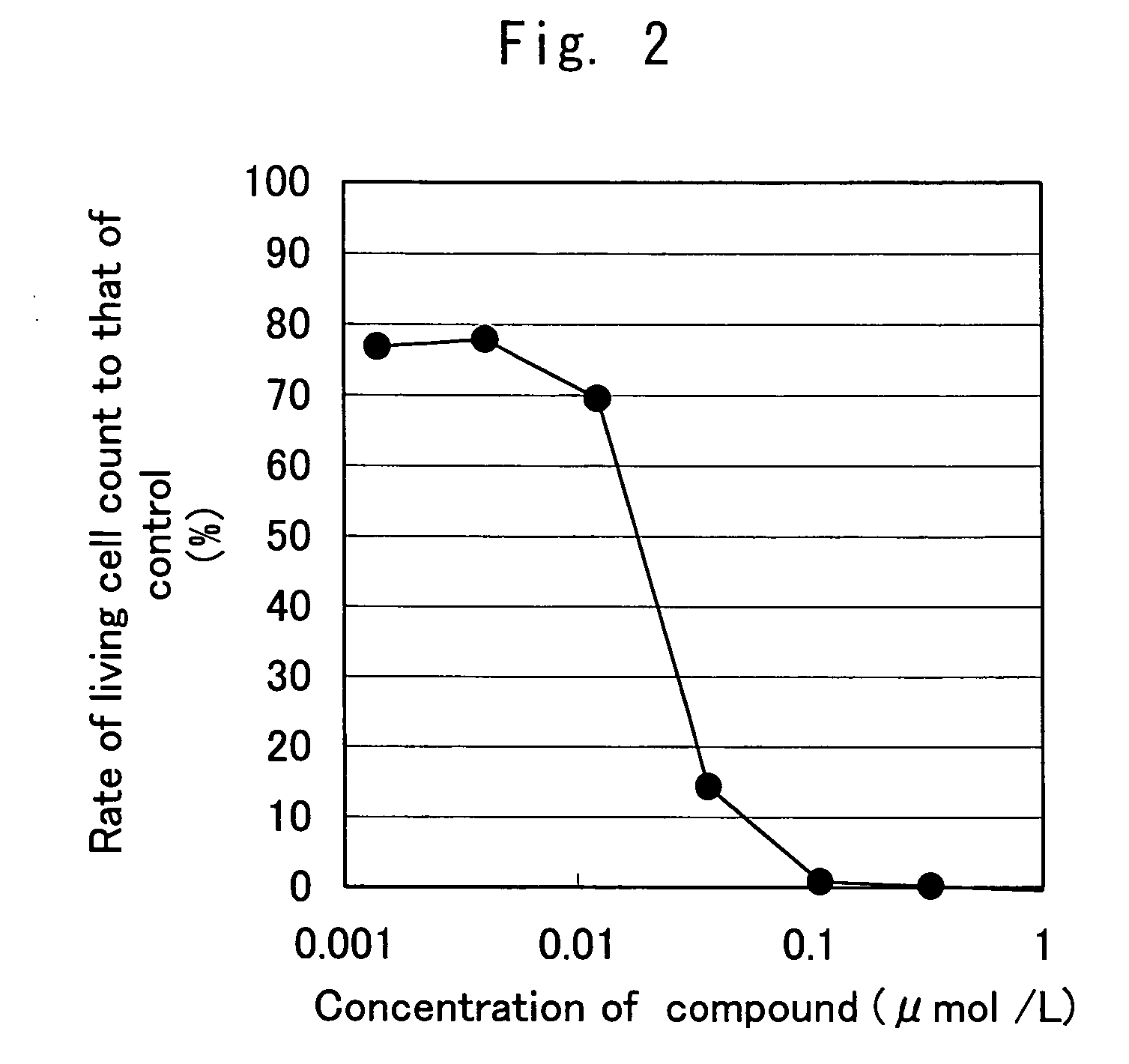Remedy for diseases associated with immunoglobulin gene translocation
a technology of immunoglobulin and gene translocation, which is applied in the direction of biocide, heterocyclic compound active ingredients, drug compositions, etc., can solve the problems that specific treatments targeted to molecules encoded by translocation partner genes whose abnormal expression is induced as a result of immunoglobulin gene translocation have not been carried out, and achieve the effect of easy production
- Summary
- Abstract
- Description
- Claims
- Application Information
AI Technical Summary
Benefits of technology
Problems solved by technology
Method used
Image
Examples
example 1
Intracellular Disappearance of a Protein Encoded by a Partner Gene in Immunoglobulin Gene Translocation Due to a Compound having an Inhibitory Action on Hsp90
[0180] It was confirmed by Western blot carried out in the following manner that, in cells with immunoglobulin gene translocation, a protein encoded by the partner gene showing abnormal enhancement of expression due to the immunoglobulin gene translocation disappears within the cells by the addition of a compound having an inhibitory action on Hsp90.
[0181] KMS-11 cells derived from human multiple myeloma [In Vitro Cell. Dev. Biol., 25, 723 (1989)], which were diluted to 10,000 cells / ml with RPMI 1640 medium containing 10% fetal bovine serum (hereinafter referred to as “culturing medium”), were put in plastic culture flasks (125 cm2, Nunc) in 30 ml portions. KMS-11 cells are reported to be the cells in which a large amount of FGFR3 is expressed as a result of translocation between immunoglobulin gene on 14q32 and FGFR3 gene o...
example 2
Growth Inhibition of Cells with Immunoglobulin Gene Translocation by a Compound having an Inhibitory Action on Hsp90
[0185] FGFR3 encoded by the partner gene in immunoglobulin gene translocation in KMS-11 cells is considered to participate in growth and malignant progression of tumors. Accordingly, the influence which a compound having an inhibitory action on Hsp90 exerts on growth of the cells by causing FGFR3 to disappear from the cells was examined.
[0186] KMS-11 cells diluted to 2×105 cells / ml with the culturing medium were pipetted into a 96-well microplate (Nunc) in an amount of 50 μl (1000 cells) per well. To each well was added 50 μl of a solution prepared by diluting a 10 mmol / l solution of KF58333 in DMSO to 600 nmol / l with the culturing medium and further serially diluting the resulting solution threefold with the culturing medium so as to make the final concentrations of KF58333 of 300, 100, 33.3, 11.1, 3.70 and 1.23 nmol / l, respectively. As a control, 50 μl of the cult...
example 3
In Vivo Antitumor Effect of a Compound having an Inhibitory Action on Hsp90
[0189] In vivo antitumor effect of a compound having an inhibitory action on Hsp90 was examined using a human tumor model prepared by transplanting KMS-11 cells to immunodeficient mice as a model of a disease associated with immunoglobulin gene translocations.
[0190] KMS-11 cells were cultured in a 5% CO2 incubator at 37° C. using the culturing medium for propagation. One day before transplantation, 0.3 mg / mouse of anti-asialo GM1 antibody was intraperitoneally administered to 10 human multiple myeloma-derived KMS-11 cell Fox C.B-17 / Icr-scidJcl mice (CLEA JAPAN). One day after the administration of the antibody, the cultured KMS-11 cells (1×107 cells / mouse) were subcutaneously transplanted to the mice. Fourteen days after the transplantation, the longer diameter and shorter diameter of the tumor subcutaneously grown were measured with slide calipers, and the tumor volume was calculated according to the foll...
PUM
| Property | Measurement | Unit |
|---|---|---|
| molecular weight | aaaaa | aaaaa |
| temperature | aaaaa | aaaaa |
| temperature | aaaaa | aaaaa |
Abstract
Description
Claims
Application Information
 Login to View More
Login to View More - R&D
- Intellectual Property
- Life Sciences
- Materials
- Tech Scout
- Unparalleled Data Quality
- Higher Quality Content
- 60% Fewer Hallucinations
Browse by: Latest US Patents, China's latest patents, Technical Efficacy Thesaurus, Application Domain, Technology Topic, Popular Technical Reports.
© 2025 PatSnap. All rights reserved.Legal|Privacy policy|Modern Slavery Act Transparency Statement|Sitemap|About US| Contact US: help@patsnap.com



